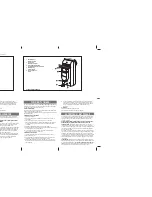
9
FA A C M o d e l S 4 1 8 S w i n g G a t e O p e r a t o r
If the size of the pillar or the position of the hinge does not
permit installation of the operator, a niche will have to be
made in the pillar (as indicated in Figure 6) in order not to
change value
A
(Figure 4). The size of the niche must be
such as to permit easy installation of the operator, not limit-
ing its rotation and allowing activation of the manual release
device.
Fig. 8
Fig. 9
Fig. 6
The rear bracket, adjustable to different positions, facilitates
the installation procedure, being adaptable to different
types of gate and limiting any modifications necessary to
satisfy installation values
A
and
B
.
Figure 7 shows certain positions which the bracket can
take; all positions intermediate to those shown may be
obtained.
Positions must be chosen which permit assembly of the
bracket, using both securing screws.
3.3.1 General Rules for Determining Installation Values
•
To obtain opening of the leaf to
90°:
A+B=C.
•
To obtain opening of the leaf more than
90°:
A+B<C.
•
Lower A and B values produce higher peripheral leaf
speeds.
•
Limit the difference between value A and value B to within
1
½
inches, greater differences may cause variations in
speed during opening and closing gate movements.
•
Maintain a Z value that keeps the operator from striking
the pillar.
• The mechanical stops intervene during the first and final
1
½
inches of the stroke. Not utilizing the entire operator
stroke could limit the possible adjustments or reduce
them to zero.
3.4
INSTALLING THE OPERATOR
To correctly install the operator, follow the procedure below:
1.
Secure the fixed part of the rear bracket in the position
determined previously, using suitable assembly systems.
In the case of iron pillars, the bracket may be welded
directly to the pilaster, see Figures 8 and 9.
During assembly procedures, check that the bracket is perfectly
horizontal using a spirit level.
6½
4⅞
4⅛
4¼
2⅞
2
2½
3¼
1½
2½
Fig. 7
Dimensions in Inches


































